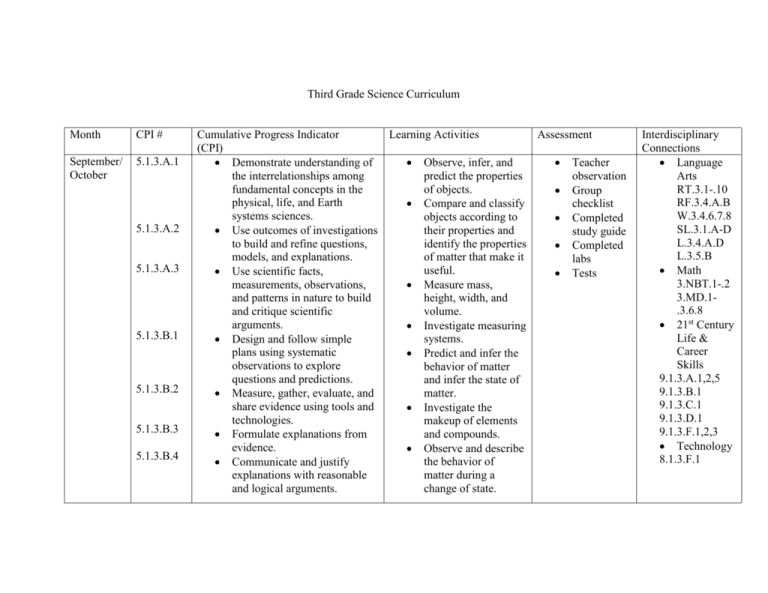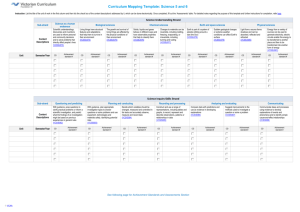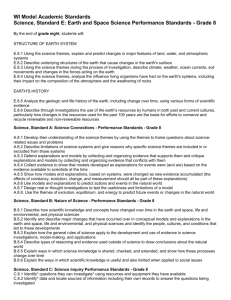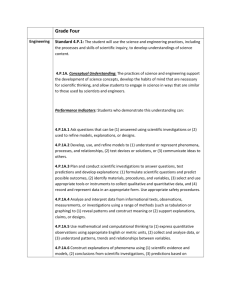Third Grade Science Curriculum
advertisement

Third Grade Science Curriculum Month CPI # September/ October 5.1.3.A.1 5.1.3.A.2 5.1.3.A.3 5.1.3.B.1 5.1.3.B.2 5.1.3.B.3 5.1.3.B.4 Cumulative Progress Indicator Learning Activities Assessment (CPI) Demonstrate understanding of Observe, infer, and Teacher the interrelationships among predict the properties observation fundamental concepts in the of objects. Group physical, life, and Earth Compare and classify checklist systems sciences. objects according to Completed Use outcomes of investigations their properties and study guide to build and refine questions, identify the properties Completed models, and explanations. of matter that make it labs useful. Use scientific facts, Tests measurements, observations, Measure mass, and patterns in nature to build height, width, and and critique scientific volume. arguments. Investigate measuring systems. Design and follow simple plans using systematic Predict and infer the observations to explore behavior of matter questions and predictions. and infer the state of matter. Measure, gather, evaluate, and share evidence using tools and Investigate the technologies. makeup of elements and compounds. Formulate explanations from evidence. Observe and describe the behavior of Communicate and justify explanations with reasonable matter during a and logical arguments. change of state. Interdisciplinary Connections Language Arts RT.3.1-.10 RF.3.4.A.B W.3.4.6.7.8 SL.3.1.A-D L.3.4.A.D L.3.5.B Math 3.NBT.1-.2 3.MD.1.3.6.8 21st Century Life & Career Skills 9.1.3.A.1,2,5 9.1.3.B.1 9.1.3.C.1 9.1.3.D.1 9.1.3.F.1,2,3 Technology 8.1.3.F.1 5.1.3.C.1 5.1.3.C.2 5.1.3.C.3 5.1.3.D.1 5.1.3.D.2 5.1.3.D.3 5.2.3.A.1 5.2.3.A.2 5.2.3.A.3 Monitor and reflect on one’s own knowledge regarding how ideas change over time. Revise predictions or explanations on the basis of learning new information. Present evidence to interpret and/or predict cause-and-effect outcomes of investigations. Actively participate in discussions about student data, questions, and understandings. Work collaboratively to pose, refine, and evaluate questions, investigations, models, and theories. Demonstrate how to safely use tools, instruments, and supplies. Identify objects that are composed of a single substance and those that are composed of more than one substance using simple tools found in the classroom Plan and carry out an investigation to distinguish among solids, liquids, and gasses. Determine the weight and Investigate the role energy plays in changes of state. Infer how lowering or raising the temperature of a substance can cause changes in its behavior. Investigate different types of physical changes. Observe how mixtures are made and identify examples of a mixture. Observe, describe, and record data about chemical changes. Compare physical changes to chemical changes. Social Studies 6.1.3.B.3 October/ November 5.2.3.B.1 5.1.3.A.1 5.1.3.A.2 5.1.3.A.3 5.1.3.B.1 5.1.3.B.2 5.1.3.B.3 volume of common objects using appropriate tools Predict and explain what happens when a common substance, such as shortening or candle wax, is heated to melting and then cooled to a solid. Demonstrate understanding of the interrelationships among fundamental concepts in the physical, life, and Earth systems sciences. Use outcomes of investigations to build and refine questions, models, and explanations. Use scientific facts, measurements, observations, and patterns in nature to build and critique scientific arguments. Design and follow simple plans using systematic observations to explore questions and predictions. Measure, gather, evaluate, and share evidence using tools and technologies. Formulate explanations from evidence. Observe different types of energy. Infer causes, and predict effects of energy at work. Predict, observe, and record different kinds of energy changes. Identify and hypothesis about how and why energy changes occur. Describe the effect of energy on temperature. Investigate the ways heat is produced. Predict, observe, and classify objects that transmit heat best. Experiment to find out which material Teacher observation Group checklist Completed study guide Completed labs Tests Language Arts RT.3.1-.10 RF.3.4.A.B W.3.4.6.7.8 SL.3.1.A-D L.3.4.A.D L.3.5.B Math 3.NBT.1-.2 3.MD.1.3 21st Century Life & Career Skills 9.1.3.A.1,2,5 9.1.3.B.1 9.1.3.C.1 9.1.3.D.1 9.1.3.F.1,2,3 Technology 8.1.3.F.1 5.1.3.B.4 5.1.3.C.1 5.1.3.C.2 5.1.3.C.3 5.1.3.D.1 5.1.3.D.2 5.1.3.D.3 5.2.3.C.1 5.2.3.C.2 Communicate and justify explanations with reasonable and logical arguments. Monitor and reflect on one’s own knowledge regarding how ideas change over time. Revise predictions or explanations on the basis of learning new information. Present evidence to interpret and/or predict cause-and-effect outcomes of investigations. Actively participate in discussions about student data, questions, and understandings. Work collaboratively to pose, refine, and evaluate questions, investigations, models, and theories. Demonstrate how to safely use tools, instruments, and supplies. Compare various forms of energy as observed in everyday life and describe their applications. Compare the flow of heat through metals and nonmetals by taking and analyzing measurements transmits heat best. Investigate the different ways heat travels through different kinds of matter. Observe the cooling effect of evaporation. Predict and measure how much sugar will dissolve in cold and hot water. Investigate how adding and subtracting heat changes matter. Describe society’s dependence on fossil fuels. Explain how alternative energy sources are used. Social Studies 6.3.3.B.1 December/ January 5.2.3.C.3 5.1.3.A.1 5.1.3.A.2 5.1.3.A.3 5.1.3.B.1 5.1.3.B.2 5.1.3.B.3 5.1.3.B.4 5.1.3.C.1 Draw and label diagrams showing several ways that energy can be transferred from one place to another Demonstrate understanding of the interrelationships among fundamental concepts in the physical, life, and Earth systems sciences. Use outcomes of investigations to build and refine questions, models, and explanations. Use scientific facts, measurements, observations, and patterns in nature to build and critique scientific arguments. Design and follow simple plans using systematic observations to explore questions and predictions. Measure, gather, evaluate, and share evidence using tools and technologies. Formulate explanations from evidence. Communicate and justify explanations with reasonable and logical arguments. Monitor and reflect on one’s Completed journal entries Describe, read, label, identify, and create models, on the basic functions of the major systems of the human body: digestive circulatory respiratory nervous skeletal muscular reproductive Investigate how, bones, muscles, brain, nervous, digestive, respiratory, circulatory, function Oral presentation commercial rubric Research body system on internet Create oral presentation using Completed journal entries Language Arts RT.3.1-.10 RF.3.4.A.B W.3.4.7.8 SL.3.1.A-D L.3.4.A.D L.3.5.B Completed labs Teacher observation Group checklist Math 3.NBT.1-.2 3.MD.1.3 Completed study guide Completed labs Oral presentation commercial rubric Technology 8.1.3.A.1.2. 3 8.1.3.F.1 Health 2.1.3.A.1 2.1.3.A.2 21st Century Life and Careers 9.1.3.A.1,2, 3.5 9.1.3.B.1 9.1.3.C.1 5.1.3.C.2 5.1.3.C.3 January/ February 5.1.3.D.1 5.1.3.D.2 5.1.3.D.3 5.3.3.A.3 5.1.3.A.1 5.1.3.A.2 own knowledge regarding how ideas change over time. Revise predictions or explanations on the basis of learning new information. Present evidence to interpret and/or predict cause-and-effect outcomes of investigations. Actively participate in discussions about student data, questions, and understandings. Work collaboratively to pose, refine, and evaluate questions, investigations, models, and theories. Demonstrate how to safely use tools, instruments, and supplies. Describe the interactions of systems involved in carrying out everyday life activities. Demonstrate understanding of the interrelationships among fundamental concepts in the physical, life, and Earth systems sciences. Use outcomes of investigations to build and refine questions, models, and explanations. word processing and clip art Identify different forms of energy Describe how energy can cause a change Compare and contrast the way in which energy is transformed Contrast potential and Teacher observation Group checklist Completed study guide Completed labs 9.1.3.D.1 9.1.3.F.1.2.3 World Languages 7.1.NM.B.5 Language Arts RT.3.1-.10 RF.3.4.A.B W.3.4.7.8 SL.3.1.A-D L.3.4.A.D L.3.5.B 5.1.3.A.3 5.1.3.B.1 5.1.3.B.2 5.1.3.B.3 5.1.3.B.4 5.1.3.C.1 5.1.3.C.2 5.1.3.C.3 5.1.3.D.1 5.1.3.D.2 Use scientific facts, measurements, observations, and patterns in nature to build and critique scientific arguments. Design and follow simple plans using systematic observations to explore questions and predictions. Measure, gather, evaluate, and share evidence using tools and technologies. Formulate explanations from evidence. Communicate and justify explanations with reasonable and logical arguments. Monitor and reflect on one’s own knowledge regarding how ideas change over time. Revise predictions or explanations on the basis of learning new information. Present evidence to interpret and/or predict cause-and-effect outcomes of investigations. Actively participate in discussions about student data, questions, and understandings. Work collaboratively to pose, kinetic energy Demonstrate that potential energy can change to kinetic and back Explain the scientific meaning of work and use a formula to calculate the amount of work done in various situations Analyze the effect of friction on moving objects Identify ways of increasing and decreasing friction Observe how the slope of a ramp affects the effort required to move an object Calculate the mechanical advantage of an inclined plane Experiment to identify the variables that determine the mechanical Tests Math 3.NBT.1-.2 3.MD.1.3 21st Century Life & Career Skills 9.1.3.A.1,2,5 9.1.3.B.1 9.1.3.C.1 9.1.3.D.1 9.1.3.F.1,2,3 Technology 8.1.3.F.1 World Languages 7.1.NM.B.5 5.1.3.D.3 5.2.3.E.1 March/ April 5.2.3.E.2 5.2.3.E.4 5.1.3.A.1 5.1.3.A.2 5.1.3.A.3 refine, and evaluate questions, investigations, models, and theories. Demonstrate how to safely use tools, instruments, and supplies. Demonstrate through modeling that motion is a change in position over a period of time. Identify the force that starts something moving or changes its speed or direction of motion. Investigate, construct, and generalize rules for the effect that force of gravity has on balls of different sizes and weights. Demonstrate understanding of the interrelationships among fundamental concepts in the physical, life, and Earth systems sciences. Use outcomes of investigations to build and refine questions, models, and explanations. Use scientific facts, measurements, observations, and patterns in nature to build and critique scientific advantage of levers Observe the force required to lift objects with pulleys Investigate different kinds of levers and pulleys Make and use a model wheel and axle Explain the effect of applying a force to either wheel in a wheel and axle Infer that air takes up space and has weight. Describe the makeup of the atmosphere. Compare the atmosphere to a green house. Observe that the Earth is warmed unevenly. Infer why warm air rises. Teacher observation Group checklist Completed study guide Completed labs Tests Language Arts RT.3.1-.10 RF.3.4.A.B W.3.4.7.8 SL.3.1.A-D L.3.4.A.D L.3.5.B Math 3.NBT.1-.2 3.MD.1.3 5.1.3.B.1 5.1.3.B.2 5.1.3.B.3 5.1.3.B.4 5.1.3.C.1 5.1.3.C.2 5.1.3.C.3 5.1.3.D.1 5.1.3.D.2 5.1.3.D.3 arguments. Design and follow simple plans using systematic observations to explore questions and predictions. Measure, gather, evaluate, and share evidence using tools and technologies. Formulate explanations from evidence. Communicate and justify explanations with reasonable and logical arguments. Monitor and reflect on one’s own knowledge regarding how ideas change over time. Revise predictions or explanations on the basis of learning new information. Present evidence to interpret and/or predict cause-and-effect outcomes of investigations. Actively participate in discussions about student data, questions, and understandings. Work collaboratively to pose, refine, and evaluate questions, investigations, models, and theories. Demonstrate how to safely use Apply that hot air rises to understanding how hot air balloons work. Describe how wind is produced. Predict and observe how temperature changes air pressure. Make and use a model of a barometer. Explain how gravity relates to air pressure. Discover how air pressure can be measured. Make and use a model of a wind vane and an anemometer. Explain how wind can be a source of energy. Make and use a model of a rain gauge. Describe the way that snow affects people around the world. Explain ways that the amount of water 21st Century Life & Career Skills 9.1.3.A.1,2,5 9.1.3.B.1 9.1.3.C.1 9.1.3.D.1 9.1.3.F.1,2,3 Technology 8.1.3.F.1 Visual and Performing Arts 1.3.3.D.1 5.4.3.E.1 5.4.3.F.1 5.4.3.G.1 5.4.3.G.2 5.4.3.G.3 5.4.3.G.4 tools, instruments, and supplies. Develop a general set of rules to predict temperature changes of Earth materials, such as water, soil, and sand, when placed in the Sun and in the shade. Identify patterns in data collected from basic weather instruments. Explain how clouds form. Observe daily cloud patterns, types of precipitation, and temperature, and categorize the clouds by the conditions that form precipitation. Trace a path a drop of water might follow through the water cycle. Model how the properties of water can change as water moves through the water cycle. vapor in the air affects the weather. Observe and classify cloud types. Identify clouds associated with different types of weather. Analyze, evaluate, and apply knowledge about weather conditions and patterns. Analyze, evaluate, and apply information about severe weather and safety precautions. Interpret data about hours of sunlight in winter and summer and its relationship to changes in seasons. Investigate how the tilt of the Earth’s axis affects the changing seasons worldwide. Infer why microclimates occur. Investigate three May/June 5.1.3.A.1 5.1.3.A.2 5.1.3.A.3 5.1.3.B.1 5.1.3.B.2 5.1.3.B.3 5.1.3.B.4 Demonstrate understanding of the interrelationships among fundamental concepts in the physical, life, and Earth systems sciences. Use outcomes of investigations to build and refine questions, models, and explanations. Use scientific facts, measurements, observations, and patterns in nature to build and critique scientific arguments. Design and follow simple plans using systematic observations to explore questions and predictions. Measure, gather, evaluate, and share evidence using tools and technologies. Formulate explanations from evidence. Communicate and justify explanations with reasonable major types of climates. Discover how scientists study climate change. Infer what plants and animals need to survive. Explain that to survive, living things must be able to live from their environment. Classify foods as of plant or animal origin. Describe how decomposers change food. Distinguish between producers and consumers. Compare and contrast herbivores, carnivores, omnivores, and decomposers. Identify sequence of feeding relationships Teacher observation Group checklist Completed study guide Completed labs Tests Language Arts RT.3.1-.10 RF.3.4.A.B W.3.4.7.8 SL.3.1.A-D L.3.4.A.D L.3.5.B Math 3.NBT.1-.2 3.MD.1.3 21st Century Life & Career Skills 9.1.3.A.1,2,5 9.1.3.B.1 9.1.3.C.1 9.1.3.D.1 9.1.3.F.1,2,3 Technology 8.1.3.F.1 Visual and Performing 5.1.3.C.1 5.1.3.C.2 5.1.3.C.3 5.1.3.D.1 5.1.3.D.2 5.1.3.D.3 5.3.3.A.1 5.3.3.B.1 and logical arguments. Monitor and reflect on one’s own knowledge regarding how ideas change over time. Revise predictions or explanations on the basis of learning new information. Present evidence to interpret and/or predict cause-and-effect outcomes of investigations. Actively participate in discussions about student data, questions, and understandings. Work collaboratively to pose, refine, and evaluate questions, investigations, models, and theories. Demonstrate how to safely use tools, instruments, and supplies. Develop and use evidencebased criteria to determine if an unfamiliar object is living or nonliving. Identify sources of energy (food) in a variety of settings (farm, zoo, ocean, forest). in a food chain. Infer that all food chains begin with a producer. Describe how food chains form food webs. Explain how a chain in one part of the food web affects the rest of the food chain. Compare the parts of living things and show how they are adapted for a certain environment. Evaluate the behavior of living things that suit an organism to a particular lifestyle. Identify defensive adaptations of organisms. Describe how chemical the adaptations of many plants can be used by people as medicines. Infer the causes of change in an Arts 1.3.3.D.1 5.3.3.C.1 5.3.3.C.2 5.3.3.D.1 Predict the biotic and abiotic characteristics of an unfamiliar organism’s habitat. Explain the consequences of rapid ecosystem change (e.g., flooding, wind storms, snowfall, volcanic eruptions), and compare them to consequences of gradual ecosystem change (e.g., gradual increase or decrease in daily temperatures, change in yearly rainfall). Compare the physical characteristics of the different stages of the life cycle of an individual organism, and compare the characteristics of life stages among species. environment. Investigate how changes animals and people make in an environment affect other living things.







